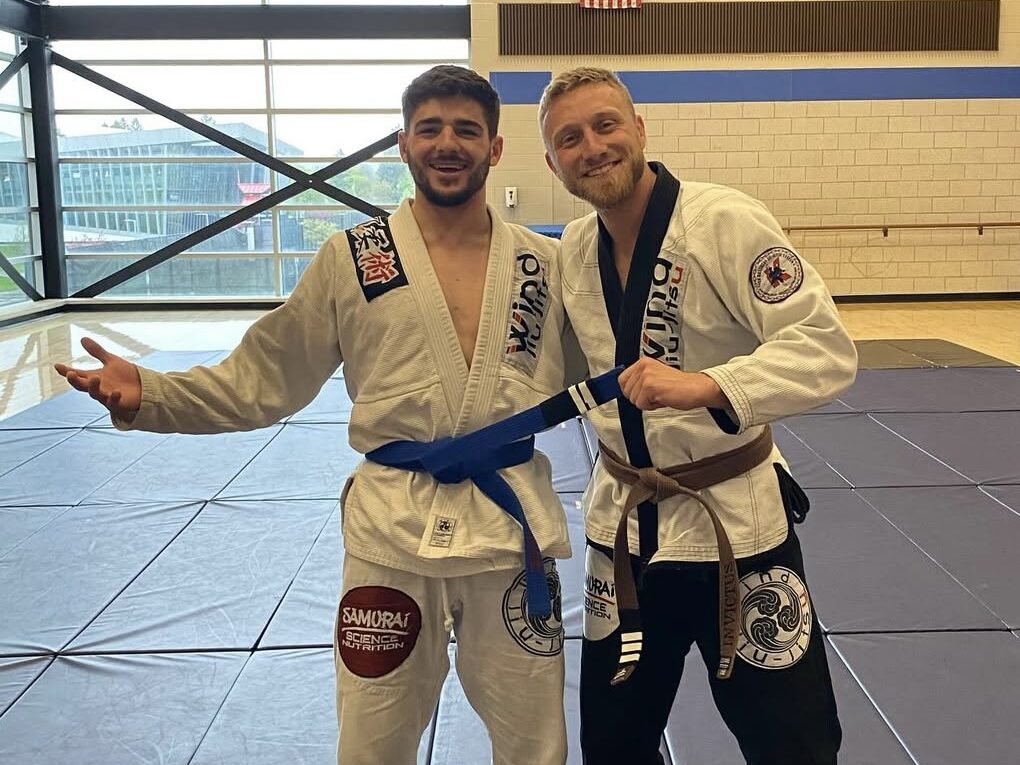
Brazilian jiu jitsu has gained popularity over the years, and practitioners often find themselves choosing between two main styles: gi and no-gi. While both forms share the same foundational techniques, they differ significantly in terms of strategy, execution, and applications, particularly when it comes to self-defense, in which I believe the more viable option in that case would be, no-gi.
At its core, gi jiu jitsu involves practitioners wearing traditional martial arts uniforms, which include a jacket (the gi) and pants. This attire allows for grips and holds that can be used to control an opponent.
Then there’s no-gi jiu jitsu, which is practiced in athletic wear, such as rash guards and shorts, which eliminate the ability to grip clothing. This fundamental difference leads to varied techniques and strategies in both styles. Blue belt and member of the SUNY Cortland jiu jitsu club, Nolan Ferguson, provided valuable insights based on his experience with both gi and no-gi.
“From my experience, I believe no-gi Brazilian jiu jitsu better prepares practitioners for self defense situations,” Ferguson said. “This is primarily because of the fact that there are more practical instances in which an attacker, or even the victim, will not be wearing clothing that can accurately simulate a gi.”
Ferguson said the importance of being prepared for real-world scenarios where clothing might not provide the same advantages as in a controlled training environment is a key factor to take into consideration.
“While some jackets may be durable enough to withstand the grabbing and pulling that many gi jiu jitsu techniques involve, it is best not to rely on the integrity of clothing to save your life.”
Feruson said that no-gi jiu jitsu focuses on techniques that work regardless of an opponent’s clothing choice, making it a more viable option for self defense.
The strategic approach in gi and no-gi competitions also varies significantly. In both formats, competitors earn points by achieving dominant positions and setting up submissions and joint locks that force an opponent to “tap out.” However, Ferguson said that gi matches require a more technical approach.
“In a gi match, one must be more technical with their movements than in no-gi,” Ferguson said. “This is not to say that technique is overrated in no-gi, but when each competitor is literally wearing a weapon, there are obviously more threats that must be taken into account.”
Ferguson likens a gi match to a series of quick chess matches, where each grip and hold can drastically change the dynamics of the encounter.
“Competitor A can take a grip on Competitor B’s gi that renders some of Competitor B’s attacks impossible until they can escape or counter that grip,” he said.
This intricate interplay of grips and positional control adds a layer of complexity to gi competitions that is less pronounced in no-gi.
Ultimately, both gi and no-gi Brazilian jiu jitsu offer valuable skills and techniques for practitioners. While gi jiu jitsu emphasizes technical grips and positional control, no-gi focuses on adaptability and practical self-defense applications.
“Each style has its merits, but understanding the differences can help practitioners choose the path that best suits their goals, whether that be competition or real-world self-defense,” said Ferguson.
From a personal perspective, and as a practitioner of no-gi jiu jitsu, I also believe that training without the gi is more relevant to real-life situations. The absence of grips and the slickness of the skin force you to rely on your movement, timing, and body positioning, which are crucial skills in self-defense. No-gi training emphasizes adaptability and fluidity, allowing practitioners to react quickly to an opponent’s movements without being restricted by fabric. While some may argue that gi training promotes control, I find that no-gi prepares me better for unpredictable encounters, making it a more practical choice for those of us who prioritize self-defense and street readiness.
For those who enjoy the competition aspect of the sport, gi may be the more suitable option as it adds layers of grips and techniques that arnt available without it. Plus, some people just prefer the traditional aspect of wearing a gi and learning the art in its classic form.
As the jiu jitsu community continues to grow, especially at SUNY Cortland, the debate between training styles will expand. However, it is important to know each style prepares practitioners in unique ways for challenges they may face on and off the mats.